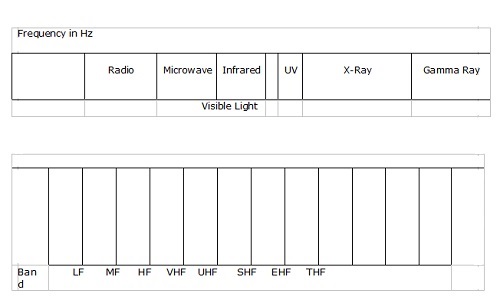
 Data Structure
Data Structure Networking
Networking RDBMS
RDBMS Operating System
Operating System Java
Java MS Excel
MS Excel iOS
iOS HTML
HTML CSS
CSS Android
Android Python
Python C Programming
C Programming C++
C++ C#
C# MongoDB
MongoDB MySQL
MySQL Javascript
Javascript PHP
PHPPhysics
Chemistry
Biology
Mathematics
English
Economics
Psychology
Social Studies
Fashion Studies
Legal Studies
- Selected Reading
- UPSC IAS Exams Notes
- Developer's Best Practices
- Questions and Answers
- Effective Resume Writing
- HR Interview Questions
- Computer Glossary
- Who is Who
The Electromagnetic Spectrum
The electromagnetic spectrum is the entire range of electromagnetic radiation according to the wavelength or frequencies. It has a range of frequencies from 1Hz to Hz. The waves in order of increasing frequencies are radio waves, microwaves, infrared rays, visible light, UV rays, X-rays and gamma rays.Among these range, the frequencies between Hz to Hz are used for communication.
The following diagram shows the electromagnetic spectrum. The first figure gives the full range of frequency spectrum while the second figure elaborates that part of the spectrum which can be used for data communication −

The section of the spectrum in the range of radio waves and microwaves has been divided into a number of frequency bands as officially referred by ITU (International Telecommunication Union). These bands are rated from VLF (Very Low Frequency) to EHF (Extremely High Frequency).
The frequency bands and their uses in communication is tabulated as follows −
| Band Name | Full Forms | Frequency Range | Propagation | Uses |
|---|---|---|---|---|
| ELF | Extremely Low Frequency | 30 – 300Hz | Ground | Power line frequencies |
| LF | Low Frequency | 3 – 300 KHz | Ground | Marine Communications, communication over twisted pair |
| MF | Medium Frequency | 300KHz –3MHz | Sky | AM radio, communication over coaxial cables |
| HF | High Frequency | 3 – 30 MHz | Sky | Aircraft and ship communications |
| VHF | Very High Frequency | 30 – 300 MHz | Sky and Line – of - Sight | FM radio, TV |
| UHF | Ultra High Frequency | 300 MHz – 3GHz | Line – of - Sight | TV, cellular phone |
| SHF | Super High Frequency | 3 – 30 GHz | Line – of - Sight | Satellite, microwave links |
| EHF | Extremely High Frequency | 3 – 300GHz | Line – of - Sight | Radar, satellite |
| Infrared | Infrared Rays | 300 Ghz – 400THz | Line – of - Sight | Consumer electronic goods |
| Visible Light | Visible Light rays | 400 THz – 900 THz | Line – of - Sight | Fiber optic communications |

